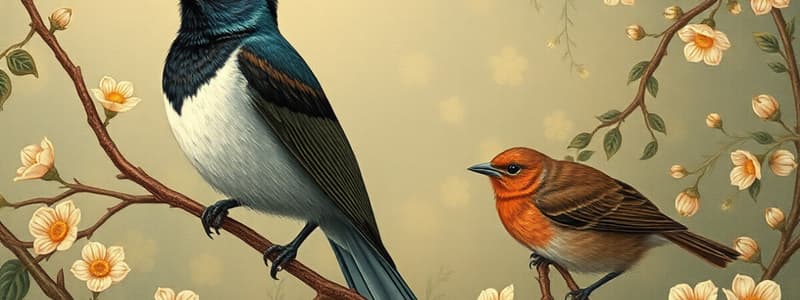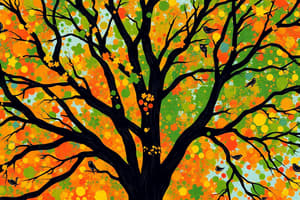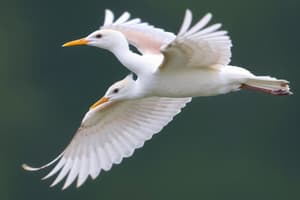Podcast
Questions and Answers
What is one major consequence of habitat fragmentation on bird populations?
What is one major consequence of habitat fragmentation on bird populations?
- Greater gene flow
- Higher mortality rates (correct)
- Increased dispersal capabilities
- Improved nesting success
Which of the following species is known to have been successfully reintroduced after facing near extinction?
Which of the following species is known to have been successfully reintroduced after facing near extinction?
- Passenger Pigeon
- Hawaiian Honeycreeper
- Carolina Parakeet
- California Condor (correct)
How have human actions contributed to bird extinction in North America?
How have human actions contributed to bird extinction in North America?
- Through the establishment of nature reserves
- By promoting bird watching activities
- Through the introduction of non-native species
- By causing habitat destruction and hunting (correct)
What role do corridors play in fragmented landscapes?
What role do corridors play in fragmented landscapes?
What significantly impacts migratory bird species from a conservation perspective?
What significantly impacts migratory bird species from a conservation perspective?
What factor has contributed to the decline in grassland bird species?
What factor has contributed to the decline in grassland bird species?
What is a common consequence of edge effects for birds nesting close to a forest edge?
What is a common consequence of edge effects for birds nesting close to a forest edge?
Which factor was responsible for the near extinction of Peregrine Falcons in eastern North America during the 1950s and 1960s?
Which factor was responsible for the near extinction of Peregrine Falcons in eastern North America during the 1950s and 1960s?
Which of the following species is known for its unique migratory pattern within Central America?
Which of the following species is known for its unique migratory pattern within Central America?
What is the estimated percentage decrease in the total population of North American birds over the past 50 years?
What is the estimated percentage decrease in the total population of North American birds over the past 50 years?
What is the term used for a rapid loss of population size leading to reduced genetic diversity?
What is the term used for a rapid loss of population size leading to reduced genetic diversity?
What factor is primarily responsible for population regulation through negative density dependence?
What factor is primarily responsible for population regulation through negative density dependence?
Which bird species example illustrates the phenomenon of density-dependent effects on reproductive success?
Which bird species example illustrates the phenomenon of density-dependent effects on reproductive success?
Which of the following species has shown significant decline due to human activities, specifically habitat loss?
Which of the following species has shown significant decline due to human activities, specifically habitat loss?
What percentage of bird species are classified as endangered, according to the IUCN Red List?
What percentage of bird species are classified as endangered, according to the IUCN Red List?
Which introduced species is known for its dramatic population increase after being released in 1896?
Which introduced species is known for its dramatic population increase after being released in 1896?
What role does citizen science play in bird population monitoring?
What role does citizen science play in bird population monitoring?
What environmental threat directly impacts bird populations through habitat degradation and loss?
What environmental threat directly impacts bird populations through habitat degradation and loss?
Which bird species faced dramatic population declines primarily due to the effects of DDT?
Which bird species faced dramatic population declines primarily due to the effects of DDT?
Which of the following is a key factor in causing short-term population fluctuations among birds?
Which of the following is a key factor in causing short-term population fluctuations among birds?
What is the expected result of increased population density in certain bird species, as evidenced by the Black-throated Blue Warblers?
What is the expected result of increased population density in certain bird species, as evidenced by the Black-throated Blue Warblers?
What significant consequence of habitat loss is frequently noted in bird populations?
What significant consequence of habitat loss is frequently noted in bird populations?
What is a direct consequence of the invasive European Starlings competing with native species?
What is a direct consequence of the invasive European Starlings competing with native species?
What factor primarily buffers short-term fluctuations in bird population sizes?
What factor primarily buffers short-term fluctuations in bird population sizes?
What is the primary reason for the significant fluctuation in the population size of Scaled Quail over time?
What is the primary reason for the significant fluctuation in the population size of Scaled Quail over time?
Which example illustrates the effects of a population bottleneck on genetic diversity?
Which example illustrates the effects of a population bottleneck on genetic diversity?
What trend has been observed regarding bird species associated with human habitats?
What trend has been observed regarding bird species associated with human habitats?
What was a significant cause of Bald Eagle population decline in North America?
What was a significant cause of Bald Eagle population decline in North America?
What major conservation action has been undertaken to address the decline of Northern Pintails in the 1960s?
What major conservation action has been undertaken to address the decline of Northern Pintails in the 1960s?
What percentage of the IUCN Red List species are classified as vulnerable?
What percentage of the IUCN Red List species are classified as vulnerable?
What human-induced factor is a primary threat to birds due to its widespread nature?
What human-induced factor is a primary threat to birds due to its widespread nature?
Which bird species shows a density-dependent decrease in fledgling numbers as population density increases?
Which bird species shows a density-dependent decrease in fledgling numbers as population density increases?
What role has citizen science played in understanding bird populations?
What role has citizen science played in understanding bird populations?
Which factor is most closely linked to the decline of endemic bird species in tropical regions?
Which factor is most closely linked to the decline of endemic bird species in tropical regions?
What is a critical impact of habitat fragmentation on bird populations?
What is a critical impact of habitat fragmentation on bird populations?
Which aspect of connectivity is most vital for conserving migratory bird species?
Which aspect of connectivity is most vital for conserving migratory bird species?
What was a significant cause behind the extinction of the Hawaiian Honeycreepers?
What was a significant cause behind the extinction of the Hawaiian Honeycreepers?
Which characteristic makes island species particularly vulnerable to extinction?
Which characteristic makes island species particularly vulnerable to extinction?
What is a notable outcome of the California Condor's reintroduction program?
What is a notable outcome of the California Condor's reintroduction program?
What is the primary reason for the significant decrease in the North American bird population over the past 50 years?
What is the primary reason for the significant decrease in the North American bird population over the past 50 years?
Which feature of corridors is essential for bird conservation in fragmented landscapes?
Which feature of corridors is essential for bird conservation in fragmented landscapes?
What was the primary driver for the near extinction of the Passenger Pigeon?
What was the primary driver for the near extinction of the Passenger Pigeon?
What ecological importance does the loss of bird species imply beyond their existence?
What ecological importance does the loss of bird species imply beyond their existence?
Flashcards
Habitat Loss from Climate Change
Habitat Loss from Climate Change
Destruction of natural environments due to changing climate patterns, especially deforestation in tropical regions.
Habitat Fragmentation
Habitat Fragmentation
Breaking up large habitats into smaller, isolated pieces, negatively impacting bird populations.
Edge Effects
Edge Effects
Negative impacts on birds nesting near fragmented forest edges, due to increased predation.
Bird Dispersal
Bird Dispersal
Signup and view all the flashcards
Conservation Corridors
Conservation Corridors
Signup and view all the flashcards
Connectivity in Conservation
Connectivity in Conservation
Signup and view all the flashcards
Extinction of Bird Species
Extinction of Bird Species
Signup and view all the flashcards
Island Birds Vulnerability
Island Birds Vulnerability
Signup and view all the flashcards
Successful Reintroductions
Successful Reintroductions
Signup and view all the flashcards
Impact of DDT on Peregrines
Impact of DDT on Peregrines
Signup and view all the flashcards
Bird Population Fluctuations
Bird Population Fluctuations
Signup and view all the flashcards
Population Growth Potential
Population Growth Potential
Signup and view all the flashcards
Population Limitation
Population Limitation
Signup and view all the flashcards
Population Regulation
Population Regulation
Signup and view all the flashcards
Population Trends
Population Trends
Signup and view all the flashcards
Population Bottleneck
Population Bottleneck
Signup and view all the flashcards
Bird Population Crashes
Bird Population Crashes
Signup and view all the flashcards
Inbreeding Depression
Inbreeding Depression
Signup and view all the flashcards
Threats to Birds
Threats to Birds
Signup and view all the flashcards
Habitat Loss
Habitat Loss
Signup and view all the flashcards
Negative Density Dependence
Negative Density Dependence
Signup and view all the flashcards
IUCN Red List
IUCN Red List
Signup and view all the flashcards
Citizen Science
Citizen Science
Signup and view all the flashcards
DDT
DDT
Signup and view all the flashcards
Introduced Species
Introduced Species
Signup and view all the flashcards
Population Density
Population Density
Signup and view all the flashcards
Population Fluctuation (Short Term)
Population Fluctuation (Short Term)
Signup and view all the flashcards
Population Fluctuation (Long-Term)
Population Fluctuation (Long-Term)
Signup and view all the flashcards
What is population limitation?
What is population limitation?
Signup and view all the flashcards
What is population regulation?
What is population regulation?
Signup and view all the flashcards
What role does citizen science play in studying bird populations?
What role does citizen science play in studying bird populations?
Signup and view all the flashcards
Challenges faced by birds today
Challenges faced by birds today
Signup and view all the flashcards
Importance of the IUCN Red List
Importance of the IUCN Red List
Signup and view all the flashcards
Where did DDT harm birds?
Where did DDT harm birds?
Signup and view all the flashcards
Deforestation's Impact
Deforestation's Impact
Signup and view all the flashcards
Endemic Species
Endemic Species
Signup and view all the flashcards
Wetland Loss & Birds
Wetland Loss & Birds
Signup and view all the flashcards
Fragmentation Effects
Fragmentation Effects
Signup and view all the flashcards
Edge Effects & Predation
Edge Effects & Predation
Signup and view all the flashcards
Migratory Bird Complexities
Migratory Bird Complexities
Signup and view all the flashcards
Extinction in Birds
Extinction in Birds
Signup and view all the flashcards
Reintroduction Success
Reintroduction Success
Signup and view all the flashcards
DDT's Impact on Peregrines
DDT's Impact on Peregrines
Signup and view all the flashcards
Study Notes
Population and Conservation
- Population: group of interbreeding individuals and their offspring
- May refer to individuals or entire species
- Fluctuations in bird populations can be dramatic (short-term) or gradual (long-term)
- Factors like storms, drought, and rainfall can cause short-term changes
- Some populations exhibit large changes over longer periods
- Introduction of House Finch to eastern North America: rapid population growth followed by decline
Growth of Population
- Birds: potential for explosive population growth
- Large-bodied: slow reproductive rates (10-30%)
- Small-bodied: fast reproductive rates (50-100%)
- Introduced species: dramatic population growth example (European Starlings)
- Introduced in NYC in 1896
- Population increased dramatically over the next century
- Major invasive pest, competing with native species
Limitation and Regulation
- Population limitation: any ceiling on population growth
- Population regulation: effects of population density on population size (negative density dependence)
- Factors influencing population size:
- Habitat
- Food
- Disease
- Predation
- Examples:
- Great Tits: mean clutch size and number of fledglings affected by density; Lay fewer eggs in high-density populations
- 60% of variation in clutch size due to population density
- Survival and reproductive rates regulated by population density
Population Trends
- Data on population fluctuations:
- Fish and Game departments (game birds)
- Extensive records of citizen science (Christmas bird counts, eBird)
- Population regulation & limitation interplay to determine population size changes
- Food limitation reduces population size & density
- Reduced density reduces negative density dependence, leading to population growth
- Ducks (Waterfowl): decline in the 1960s
- Northern Pintails: drop from 10M breeding pairs to 1M in breeding pairs
Example: Black-throated Blue Warbler
- Density-dependent stabilization on breeding grounds: young fledged decreased as population density increased.
- Rate of population grows (r) is negatively related to population density
State of Birds Today
- Many bird species are threatened, endangered, or declining.
- Greatest threat in high-diversity tropical areas due to developing countries/high human pop. pressure
- 1/3 of US species require urgent conservation action
- Migratory species, grassland species, those with small ranges are at risk
- Species associated with humans are increasing in number (Rock Pigeons, European Starlings, House Sparrows, etc.)
Endangered Species
- Classifies species by risk of extinction (IUCN Red List)
- Examples: Parrots
- 673 endangered species globally
- 787 vulnerable globally
- 66 species data deficient
- 28% of species threatened, 56% decline; only 9% increasing
Threats
- Bird species are threatened by habitat loss, climate change, disease, chemicals, collisions, hunting, and fishing (bycatch).
- Human induced factors: habitat loss, climate change, disease, (human-introduced avian malaria), chemicals, collisions, hunting & fishing
Birds and DDT
- Pesticide applications (especially DDT) led to population declines for birds.
- DDT interferes with eggshell production, causing population declines (Bald Eagles)
- Populations increased after DDT bans in 1973
- Brown Pelicans also suffered eggshell problems due to DDT, placed on endangered species list in 1973
Habitat Loss
- Habitat loss is the greatest current threat to birds.
- Direct losses through habitat destruction
- Reduction in habitat quality due to fragmentation, invasive species, etc.
- Loss of habitat due to changing climate
Fragmentation
- Fragmentation of habitats increases mortality and decreases dispersal.
- Edge effects – negative impacts of nesting close to forest edges, increased nest predation.
- Corridors are crucial for fragmented landscapes, providing connectivity for dispersal, gene flow, and local migrations.
Connectivity
- Birds are unique for their ability to connect distant locations, complicating conservation efforts for migratory species.
- Important to conserve both breeding and wintering grounds (often different pressures).
- Often within continents (e.g., Resplendent Quetzals in Central America) or between continents (many species).
Extinction
- Humans have caused many bird extinctions (Passenger Pigeon, Carolina Parakeet, many Hawaiian Honeycreepers, New Zealand Moas, Dodo, Elephant Bird of Madagascar).
- Island species are particularly vulnerable
Reintroductions
- Successful programs for species near extinction (Whooping Cranes, Peregrine Falcons, and California Condors)
- DDT drove Peregrine Falcon populations to near extinction in eastern North America, but reintroduction efforts reversed the decline
- Nesting boxes in cities for reintroduction efforts
Frightening Reality
- Total North American bird population has decreased by one-third over the past 50 years.
- Habitat loss (breeding and wintering grounds), climate change, and loss of species will have increasingly critical impacts extending beyond the birds themselves.
- Example of loss: Largest vulture in North America, once widespread (last individual captured from wild in 1987). Raised in captivity, first reintroduction in 1992, and slow recovery (488 living wild in 2018).
Studying That Suits You
Use AI to generate personalized quizzes and flashcards to suit your learning preferences.




